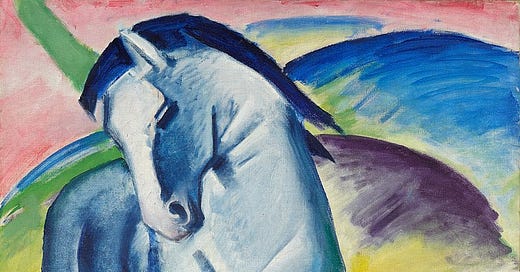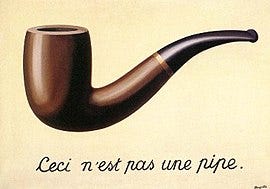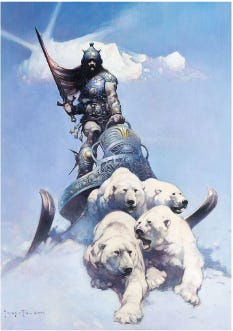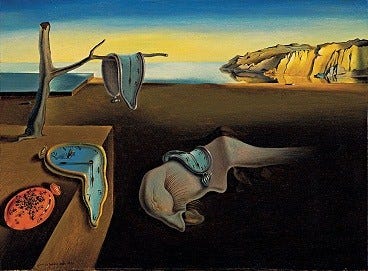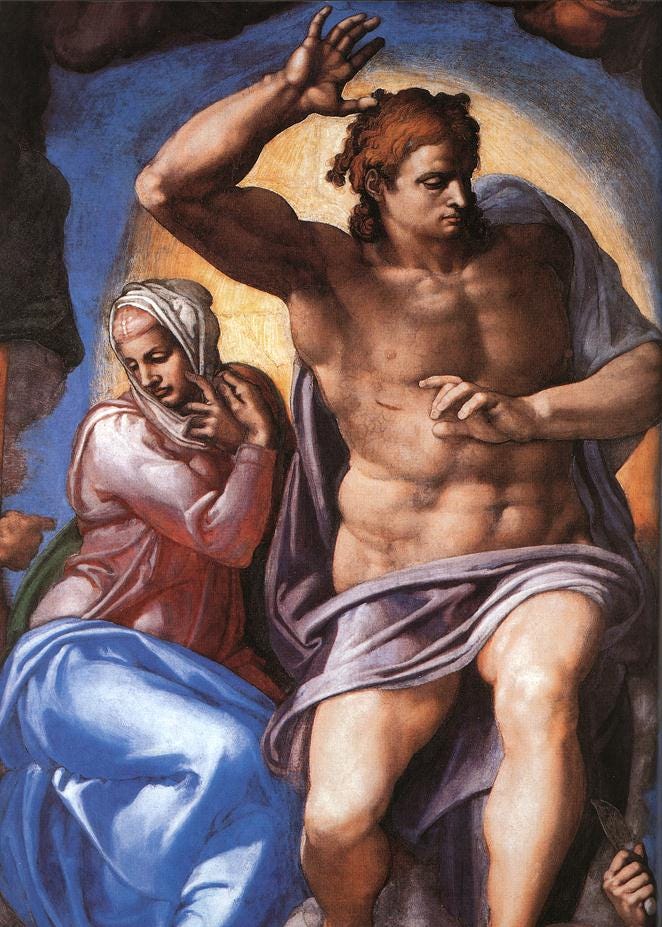This is an easy question for me to answer. As the subtitle says - as the name of my Substack says! - I want to be an artist because art is the most honest thing I can do.
The more difficult part is explaining what, exactly, I mean by art being the most honest thing I can do.
It’s especially difficult to explain because, in a sense, art is anything but honest. Artists are like magicians: they create illusions by taking advantage of how people see things. Like a good leger-de-main magic show, there are elements of distraction and illusion in art - that is, there are elements of dishonesty.
But it remains true that art is the most honesty thing I can do.
That art is honest is an antimony. The tree I draw is not that tree. It's not even three dimensional. When I paint Devil's Tower, I'm not even painting, per se, so much as plopping on blobs of paint and moving them around.
I’m not unique in these sentiments. Magritte’s weirdly controversial La Trahison des Images states what I’m implying outright: “ceci n’est pas une pipe.”
As Magritte said,
The famous pipe. How people reproached me for it! And yet, could you stuff my pipe? No, it's just a representation, is it not? So if I had written on my picture "This is a pipe", I'd have been lying!1
A less “on the nose” example may be appropriate. Consider this stunning illustration by Frank Frazetta, Silver Warrior, originally created for the Michael Moorcock novel The Silver Warriors2 (1972):
What do you see? I see a warrior atop a sleigh being pulled by four polar bears. Do you see the same thing? Let’s assume you do. Now, answer this question: how are the bears pulling the sleigh? There are no harnesses and no reigns. But it appears to me - at first and even at the 500th glance - that the warrior is holding tightly to the reigns. But he’s not; he’s holding tightly to the sleigh itself.
Frazetta purposely left out the reigns and other tack because he found them too distracting3. But he knew that our brains would fill in the details. Our brains like to do this. It’s why pareidolia is so common, why we see dragons in clouds or faces in rocks4.
This may not seem like an act of deception, but it really is: artists claim to create something representative of reality, but they’re not really doing so5. They’re creating something completely new. But we’ve bought into the show, we believe the magician - we’ve crossed into the fourth wall, not the other way around.
Neil Gaiman, speaking of writing, admitted that “We who make stories know that we tell lies for a living.” Artists are no different.
Think of it this way: painting is really - in empirical reality - just pigment in binder pushed around on a support reflecting certain wavelengths of light and absorbing others. But that is not what we’re thinking - heck, it’s not even what we’re seeing - when we look at a painting that we really like. We’re thinking things like “why is Mona Lisa smiling?”
The surrealists are a great example of what I’m suggesting, here. (Magritte was a surrealist, after all.) People don’t look at Dali’s The Persistence of Memory and think "wow, Salvador sure did apply a bunch of pigments suspended in binder to a support and wow are those blues absorbing every other wavelength!” No, we think something along the lines of “why is that clock melting” or, more commonly, “what is going on here?” In reality, nothing beyond the pushing of pigment in binder around on a support is going on (except, of course, the wavelength thing). But Dali has convinced us that there is, in fact, much more going on.
The impressionists, fauvists, and German expressionists, to name only three groups, are very clear examples of what I’m talking about here. That horse is not really blue, Franz.
But it’s just as true for the old masters. Look at Michelangelo’s Jesus from his Final Judgment. If we pause and really consider this image, we’d likely realize that this is not an accurate portrayal of what a man looks like. But for Michelangelo, at this point in his artistic career, he was experimenting with Mannerist tendencies to exaggerate proportions. This is a major departure from the ideal proportions of his David. But we accept both as being representative of a man.
How, then, can anyone claim that art is an act of honesty? I think I can fruitfully borrow from Neil Gaiman again to help explain this. Continuing the quote from above:
But they are good lies that say true things, and we owe it to our readers to build them as best we can. Because somewhere out there is someone who needs that story. Someone who will grow up with a different landscape, who without that story will be a different person. And who with that story may have hope, or wisdom, or kindness, or comfort. And that is why we write.
Given how much that visual art is narrative, any adjustments to Gaiman’s quote to apply it more directly to art are, simply, superfluous.
Great art - real art - is honest because it tells a truth in such a way that it resonates with someone. This happens because the artist both bares and bears it all during the creative process. Done right, the force of their art can only arrest the person for whom it was intended.
Howard Pyle perhaps said it best: “These are not real trees - they are only paint. A bird could not fly through the foliage without getting tangled up in the paint.” Yet earlier in this same lecture he also stated “That is the value of pictures to make us feel life and truth! … Respect the truth.” As the recorder of Pyle’s words put it, “Mr. Pyle[ … believed art was life and truth, and as such to be appreciated by everybody, ...”
As Magritte said, “…if I had written on my picture ‘This is a pipe’, I’d have been lying!”
There’s not room here to talk about the full implications of Magritte’s “infamous” piece, but consider its title: The Treachery of Images. For Magritte, there’s more than white lies when it comes to the inherent dishonesty in art. There’s actually an element of deliberate and even malevolent deception.
Specifically for book two in the series, Eternal Champion.
His daughter-in-law Lori explained this to me when I visited the Frazetta Art Museum just outside of East Stroudsburg, PA. You should go; they’re freaking awesome people.
Or why two people remember the same event so differently…
This is true even for abstract painters. Maybe there’s an argument that non-objective artists are not trying to be representative, but they are claiming to create something; but at the end of the day, all they’ve done is push some pigment around on paper.

